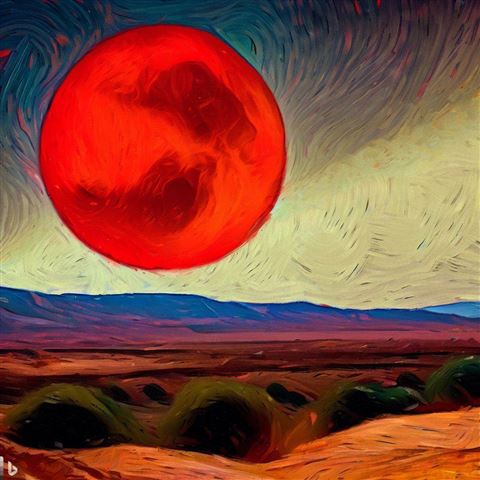
Red Moon Rising, in the style of Vincent van Gogh – AI image generated for me on 29/7/2023.
On the night of 13-14 March some areas will for the first time in 2 and a half years witness a full Blood Moon Eclipse, lasting 65 minutes. This global event will occur at the same time across the world. Although the point of greatest eclipse will be in the Pacific Ocean, North America and South America will get the best views. Some areas of Europe will get a slight view of the moonset, and East Asia will glimpse the spectacle at moonrise. Maximum eclipse on Friday at 2:58am EST; 1am Central Time ... Whatever. Check with your local news outlets when the best time would be for viewing it in your area.
Many moons ago – 15 April 2014, to be exact – I was privileged to witness a partial Blood Moon Eclipse where I lived in the Karoo region (a semi-desert area in South Africa devoid of light pollution). We are not favourably placed in the moon’s revolution around the earth, and the shadow (umbra) during a lunar eclipse. The information I had was that the eclipse would start at approximately 2 in the morning and last till about 4 o’clock. So, picture me sitting outside on my deckchair in the freezing cold night air waiting since 2 am for this magical apparition that only lasted for a short period of time. But it was well worth it!
I wrote a short minimalist poem in anticipation of the current event drawing on my memories:
broken blood moon
calm mountain lake waters
restores it
Light or Shadows
I was toying with the idea to have this event as my current contest topic, but settled instead on Suzette Prime* for the Light or Shadows contest as it is more emotionally abstract.
Emotionally abstract often refers to an idea, feeling, or situation that is not easily understood or expressed in clear, concrete terms. Think of it as something that evokes emotions or feelings in a vague or indirect way, rather than through explicit or straightforward means. In other words: Show, don’t tell.
‘Show, don't tell’: This principle encourages writers to convey emotions and themes through vivid imagery, sensory details, and actions rather than simply stating how characters feel. This approach allows readers to experience the emotions more viscerally and form their own interpretations.
In the context of an emotive poem, using emotionally abstract elements can be very effective. Instead of directly stating emotions, the poet might use metaphors, symbols, and evocative descriptions to create a mood or atmosphere. This way, the reader can feel the emotions without them being explicitly described.
For example, instead of writing ‘I felt sad’, a poet might describe a scene like ‘A lone leaf falls from the ancient oak, whispering secrets to the silent ground’.
It's all about engaging the reader's senses and imagination to evoke a deeper emotional response.
The aforementioned haiku can be viewed as emotionally abstract. It paints a vivid image with its words, but leaves the interpretation up to the reader - the hallmark of haiku. The abstract nature comes from the imagery and the emotional response it evokes without explicitly stating any concrete emotions or events. The reader is invited to find their own meaning and feelings within the poem.
My example poem for the two contest prompts (quotes):
Light and Shadows (poetrysoup.com)
Happy quills!
Su
*Suzette Prime - the story behind it | PoetrySoup.com